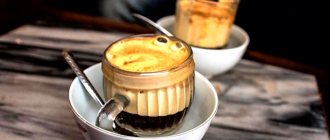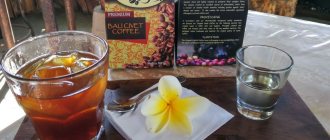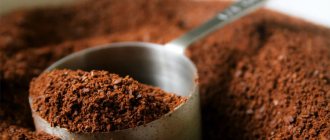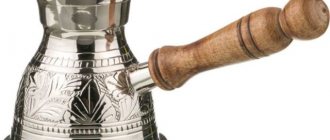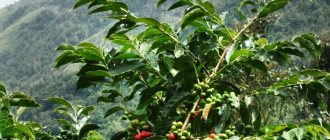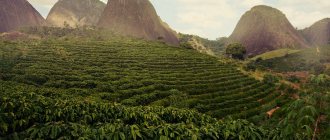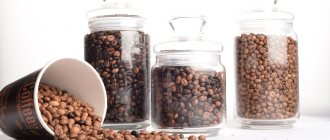The drink with which most people start their mornings is considered one of the attractions of Vietnam. Coffee in Vietnam is sold everywhere: at street food stalls, beach eateries, coffee shops and restaurants. Vietnamese food is not to everyone's taste, but the coffee in this exotic country is excellent. The secret of taste and aroma lies not only in the types of coffee beans, but also in the preparation method. The ground beans are brewed in press filters, or “fins,” like tea leaves. Learn how to brew Vietnamese coffee at home and enjoy its unique taste and aroma every morning.
How to brew coffee using a filter press
The Vietnamese way of preparing the drink is simple. While the coffee is brewing, you can do other things. But brewing Vietnamese coffee in a Turkish coffee pot is not the best idea: it will have a bitter aftertaste. Here is a step-by-step classic recipe:
- Pour boiling water over the filter so that the ground coffee soaks and does not spill through the strainer into the cup.
- Add 2-4 teaspoons of coffee and add a few drops of boiling water.
- Grind the ground coffee using a press.
- Place the filter on a cup or glass.
- Apply a press and press down.
- Fill the filter with hot water.
- Cover with a lid.
Having taken away the taste and aroma of coffee beans, the water will completely pass through the filter in 10-15 minutes. To make it easier to track this moment, it is better to brew coffee the Vietnamese way in a glass cup. Do not lift the filter lid during brewing. You can add sugar to the finished drink to taste. The hosts will be happy to show tourists staying at the guest house how to brew Vietnamese coffee correctly. .
Those staying at the hotel can take a master class from a street food vendor: just order coffee and say that you want to watch the process of making the drink.
To avoid dehydration, increased blood pressure and plaque on the teeth, it is advisable to drink some plain still water after coffee.
Historical reference
Coffee beans were introduced to this quiet Asian country in the 19th century. There is even a mention of when exactly this happened - it was 1857. Only then did it occur to one of the French colonists to take some coffee with them, make a drink from it and give it to the locals to try. They appreciated the taste and began to grow the plant for themselves.
- This is interesting: Where coffee first appeared and how it came to us
For a long time, travelers in Vietnam could see coffee trees only in the backyards of some houses. Residents liked the drink, and each craftsman grew his own grains. Perhaps at this time, local amateurs developed a method of preparing Vietnamese coffee in a mug - more precisely, in a special installation designed specifically for such beans. In any case, there was plenty of time for this...
Only at the beginning of the twentieth century did someone in Vietnam realize that a good business could be built on this by growing coffee on plantations.
And then everyone realized that this was a real “gold mine.” Now the export of grains here is so well established that Vietnam is even ahead of Brazil.
In the country itself, the annual coffee harvest is almost equal to the volume of rice, and the best part of it is harvested in the highland region of Dalat. This goodness is enough not only for other countries, but also for local residents and tourists - brewing Vietnamese coffee using a special technology is now offered on literally every corner, and the shelves in stores are bursting with a variety of varieties.
Coffee with milk
When accepting an order, a waiter in a cafe or a street food vendor will definitely ask if you need more milk. In Vietnam they only drink coffee with condensed milk. It gives the drink a delicate creamy taste. In this case, no sugar is added - otherwise the drink will be too sugary. The Vietnamese do not add milk to coffee, but a ready-made drink with milk. How to prepare cà phê sữa – milk coffee:
- Place 1-2 tablespoons of condensed milk into an empty cup.
- Brew coffee using a method you already know.
- Stir.
If you are used to drinking milk coffee, but condensed milk seems too high in calories and heavy, there is a recipe for making a flavorful drink with regular milk.
- Pour milk into a mug.
- Add sugar if you drink your coffee sweet.
- Place the milk and sugar in the microwave for 30-80 seconds (depending on the power of the oven and the amount of milk). Make sure it doesn't boil. You can also heat the milk on the stove.
- Try to immediately place the coffee filter on the cup, otherwise milk foam may form.
The nuances of serving and drinking
Vietnamese coffee traditions have their own characteristics:
- The drink is served in glasses or special mugs.
- Coffee is not boiled, but brewed in a metal dropper cup with holes in the bottom.
- The default drink is as strong and sweet as possible. If you want it without sugar or condensed milk, you need to ask the barista about this in advance.
- It is not customary to serve cookies and other desserts with coffee, since drinks are almost always prepared with hearty additives, for example, condensed milk or egg.
Vietnamese iced coffee
This drink is no less popular in Vietnam than hot coffee. Vietnamese ice coffee is a great thirst quencher on a hot day and tastes like a coffee-flavored milkshake. It can be either with or without condensed milk.
The recipe for brewing iced coffee in the Vietnamese style is simple: you need to add ice cubes to the drink. It is advisable to drink it before the ice begins to dissolve, otherwise the taste will not be rich.
What condensed milk is suitable for Vietnamese coffee?
In Vietnam, condensed milk of plant origin is more common. Typically coconut. It is important to note that such condensed milk does not have the cloying smell of coconut and is practically indistinguishable in taste from condensed milk made from whole milk of animal origin.
Condensed milk with animal cream became widespread in Vietnam during the period of development of trade relations with the USSR. They say that the Vietnamese fell in love with GOST condensed milk, but it is extremely rare on the shelves of ordinary supermarkets.
In addition to canned condensed milk, dry coconut cream is widely used in cooking in Vietnam. You can quickly make improvised condensed milk from them by dissolving dry vegetable cream in a small amount of water.
Benefits of Condensed Milk from Dry Coconut Cream
:
- Low calorie content - coconut cream itself is quite sweet due to the natural sugars it contains; additional sugar should only be added to those with an avid sweet tooth;
- Vietnamese coffee with condensed milk from coconut cream is the same coffee with milk for weight loss;
- Does not require storage in the refrigerator - dry coconut cream can be stored at room temperature without loss of taste and quality properties;
- Suitable for people with intolerance to cow's milk protein and animal products.
Besides all that, dry coconut cream is simply delicious!
Egg coffee
The recipe for egg coffee was invented by the Vietnamese Nguyen Van Giang in Hanoi in the 40s of the last century. This drink is popular in Northern Vietnam, but is rare in coffee shops in Central and Southern Vietnam. The drink is unique: some consider it divine, while others do not like the eggy taste. You can make coffee with eggs at home. Ingredients:
- black coffee;
- egg;
- condensed milk;
- sugar.
Cooking method:
- Brew coffee.
- Separate the egg yolk from the white.
- Beat the yolk with sugar and condensed milk until smooth.
- Carefully pour the resulting mixture into the coffee.
If you are planning to prepare Vietnamese coffee for several people and are afraid that someone will not like the eggy taste, take one yolk for two servings. Add only fresh egg yolks to your coffee.
Signature roast
The secret of the unique taste and smell of Vietnamese coffee is in roasting the beans along with cocoa beans. This method is used only within the country.
Signature roasting is the secret of the unique taste of coffee.
To give the product additional flavor shades, add:
- powdered milk;
- diluted condensed milk;
- fruit syrup;
- sugar;
- hazelnut or walnut oil.
Classic Vietnamese coffee is highly roasted; coconut oil is added to the cocoa beans.
Where to buy Vietnamese coffee
When you return home, you will want to enjoy your favorite taste of Vietnamese coffee in the morning, so buy several kilograms during your trip. 100 g of Vietnamese coffee is enough for a week, provided that two people drink a cup of hot drink every morning. Good varieties in Vietnam cost only $5-10 per 500 g. If you are vacationing in Nha Trang or neighboring cities, it is best to buy coffee where it is grown: in Dalat or Dak Lak province. Prices there are lower than in tourist areas, and the chance of buying a fake is extremely low. It is best to buy the product in specialized stores (for example, La Viet Coffee in Dalat) and in local markets - tourist shops sometimes sell cheap varieties of coffee under the guise of expensive ones or add wood shavings to the ground beans. Excursion programs around Dalat and Dak Lak often include tasting of various types of coffee. Before it, tourists are usually shown how to brew coffee using a press filter, and after that they are offered to buy coffee beans of the variety they like. Keep in mind that coffee is sold at a high premium on excursions.
In Russia and other CIS countries, Vietnamese coffee can be bought in online stores or elite coffee boutiques, and prices for the product are 3-5 times higher than in Vietnam. A press filter can also be brought back from travel. In Vietnamese markets, this device can be bought for 15,000-50,000 VND (40-125 rubles). Prices in Russian specialized stores start from 250 rubles.
Contraindications for use
Coffee can provoke undesirable consequences if a person has diseases and problems such as:
- insomnia;
- anxiety states;
- heart diseases;
- hypertension;
- stomach diseases;
- cholecystitis;
- glaucoma;
- cirrhosis of the liver.
Is it possible to occasionally allow yourself to drink a cup of aromatic drink if you have such pathologies? It’s better to check with your doctor.
In the producing country, coffee is today the second most exported product (after rice), but in Russia it is just beginning to become widespread, so the packaging of the original drink will be a good souvenir from Vietnam.
Vietnamese coffee varieties
The most popular types of coffee beans in Vietnam are Arabica and Robusta. Their varieties are sold both in pure form and mixed with each other in various proportions. But Luwak, extracted from animal excrement, is an attraction for tourists. The drink made from beans of this variety, offered at tastings, does not differ in taste from ordinary Robusta, and its “special” taste properties are caused by self-hypnosis. If you want to try real elite coffee, pay attention to excelsa - the rarest type that is part of exquisite varieties. When tasting coffee in Vietnam, trust not advertising, but your own taste sensations. Buy the varieties that you really like. And let your morning begin with the most delicious coffee in the world!
Previous
CuisineSeafood restaurants in Nha Trang: where to eat fish and seafood
Next
CuisineWhere to buy seafood in Nha Trang
Interesting Facts
Few people know, but Vietnam is firmly the second largest coffee exporter in the world. More than 500 thousand hectares of the country's land are allocated for plantations, on which about 1 million tons of coffee beans are grown. Harvesting, thanks to the humid and warm climate, takes place almost all year round.
Vietnam sells ground, instant, and also in the form of green or roasted beans. But Vietnamese roasting is somewhat different from the usual one. The final product contains a lot of caffeine, which is due to processing at low temperatures using refined vegetable oil.
The main type of coffee bean grown in Vietnam is Robusta. The following are cultivated and produced in much smaller volumes:
- Arabica;
- excelsa;
- Luwak mines;
- Kuli coffee.
Thanks to the successful combination of the country's climate and the unpretentiousness of the coffee tree, with the exception of Arabica, consistently high yields allow us to focus on the quality of the resulting product. Criteria that receive special attention:
- balanced taste;
- presence of sourness;
- good saturation;
- roasting, acceptable for any cooking method.
What kind of coffee is suitable for cooking in Finland?
To prepare coffee in Finland, you should give preference to medium-ground coffee. Finely ground coffee is more suitable for cooking in a Turk, and it can simply clog the perforated filter. If you use coarsely ground coffee to make coffee in Finland, the taste will be less intense and the drink will be less aromatic. But this option is liked by those who prefer more European tastes of coffee and a lower density of the drink.
Recipe with rum
Ingredients:
- Two tablespoons of medium-ground beans;
- Two spice cloves;
- One hundred milliliters of water;
- A pinch of cinnamon;
- One hundred milliliters of rum;
- Sugar to taste.
Cooking method:
- The cooking method is very simple.
- Combine all ingredients in a container, place over high heat and bring to a boil.
- Turn off the heat and pour the Vietnamese drink into cups.
- Coffee prepared according to this recipe has a wonderful aroma and warms perfectly.
Enjoy your coffee!
Benefits of brewing coffee in Finland
Why do Vietnamese people prefer to brew coffee using the drip method using a traditional coffee fin? This method has a number of undoubted advantages:
- Allows you to brew any coffee, including those prepared in a traditional or original way, caramelized, with specific natural additives;
- Does not require electricity;
- Coffee prepared in Fin is richer and more aromatic;
- Filter coffee is healthier;
- Brewing in a fin is also a meditative process, in which you can immerse yourself while watching the process of preparing coffee, slowly dripping into a glass.
What kind of coffee grows in Vietnam?
95-97% of coffee from Vietnam is Robusta
Vietnam “specializes” in the production of robusta, and this is due to the fact that robusta can be grown at low altitudes, the plant is resistant to diseases and harmful insects (insects simply cannot withstand such caffeine content).
And most importantly, the robusta tree produces a very large harvest.
The result is a lot of cheap coffee, which is great news if flavor and aroma are left out. Many will argue that they love the taste of Vietnamese coffee and that they have never tasted anything tastier in their life. How this happens, you will find out below.
Flowering Robusta tree in Vietnam, near Dalat
Vietnamese iced coffee latte with tapioca
Ingredients:
- Tapioca (can be replaced with regular starch) 100 g
- Ground coffee 30 gr
- Water 625 ml
- Brown sugar 2 tbsp. l.
- Condensed milk 85 ml
- Ice 2 cups. (200 ml)
- Cream 125 ml
Cooking method:
- Place tapioca balls into boiling water.
- Cook for 15 minutes.
- Place in a colander or sieve and allow excess liquid to drain.
- Rinse in cold water.
- Place in a separate bowl with a minimum of water to cool.
- Water is needed to prevent the tapioca from sticking together.
- In another bowl, boil water again.
- Add coffee (ground) and let simmer over low heat for 10 minutes.
- Add sugar and condensed milk to the coffee liquid.
- Stir and refrigerate for 10 minutes.
- Place tapioca (2 tablespoons) at the bottom of the glasses and cover with ice cubes.
- Pour coffee almost to the brim of the glass, and pour cream on top.
- Beauty and yummy.
- Let's try and enjoy.
Enjoy your coffee!
Drink recipe with condensed milk
You will get a more refined coffee if you brew it with the addition of condensed milk. The highlight of this recipe is that the drink is carefully poured into the condensed milk without mixing the ingredients.
Ingredients:
- Two teaspoons of ground grains;
- A few tablespoons of condensed milk;
- One hundred milliliters of boiling water.
Cooking method:
- Pour condensed milk into a cup, place a press filter on top and wait for the drink to brew.
- When it's ready, remove the filter.
- If you brew it in a transparent glass container, you will see a clear line between the white milk and the black drink.
- Now you can mix everything and enjoy delicious sweet Vietnamese coffee.
- You can vary this recipe by adding ice cubes at the end.
Enjoy your coffee!
Coffee from Vietnam comes in different varieties.
Let's start with the fact that coffee comes in different varieties . Just like there are different types of chocolate, tea, wine or beer. In short, there are 2 main genera of coffee trees and they will give us completely different tastes of coffee: Robusta and Arabica.
Robusta for you and me means a bitter taste, a high caffeine content (which sometimes leads to rapid heartbeat and anxiety) and a low price.
Arabica has taste and aroma, moderate caffeine content, and at the same time a pleasant invigoration from the drink.
